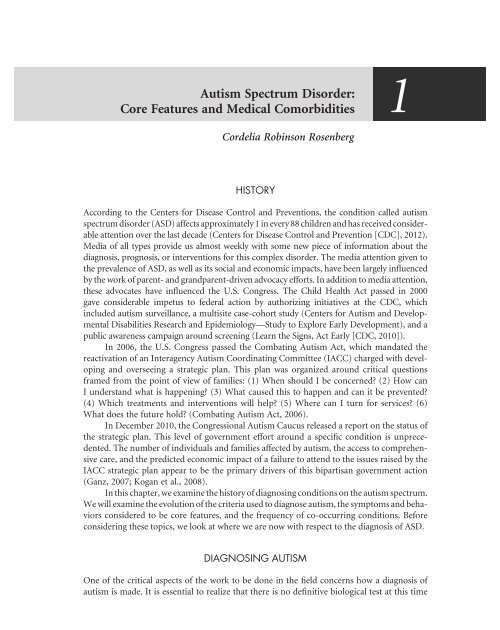Nursing of Autism Spectrum Disorder - Springer Publishing
Nursing of Autism Spectrum Disorder - Springer Publishing
Nursing of Autism Spectrum Disorder - Springer Publishing
Create successful ePaper yourself
Turn your PDF publications into a flip-book with our unique Google optimized e-Paper software.
1<br />
<strong>Autism</strong> <strong>Spectrum</strong> <strong>Disorder</strong>:<br />
Core Features and Medical Comorbidities<br />
Cordelia Robinson Rosenberg<br />
HISTORY<br />
According to the Centers for Disease Control and Preventions, the condition called autism<br />
spectrum disorder (ASD) affects approximately 1 in every 88 children and has received considerable<br />
attention over the last decade (Centers for Disease Control and Prevention [CDC], 2012).<br />
Media <strong>of</strong> all types provide us almost weekly with some new piece <strong>of</strong> information about the<br />
diagnosis, prognosis, or interventions for this complex disorder. The media attention given to<br />
the prevalence <strong>of</strong> ASD, as well as its social and economic impacts, have been largely influenced<br />
by the work <strong>of</strong> parent- and grandparent-driven advocacy efforts. In addition to media attention,<br />
these advocates have influenced the U.S. Congress. The Child Health Act passed in 2000<br />
gave considerable impetus to federal action by authorizing initiatives at the CDC, which<br />
included autism surveillance, a multisite case-cohort study (Centers for <strong>Autism</strong> and Developmental<br />
Disabilities Research and Epidemiology—Study to Explore Early Development), and a<br />
public awareness campaign around screening (Learn the Signs, Act Early [CDC, 2010]).<br />
In 2006, the U.S. Congress passed the Combating <strong>Autism</strong> Act, which mandated the<br />
reactivation <strong>of</strong> an Interagency <strong>Autism</strong> Coordinating Committee (IACC) charged with developing<br />
and overseeing a strategic plan. This plan was organized around critical questions<br />
framed from the point <strong>of</strong> view <strong>of</strong> families: (1) When should I be concerned? (2) How can<br />
I understand what is happening? (3) What caused this to happen and can it be prevented?<br />
(4) Which treatments and interventions will help? (5) Where can I turn for services? (6)<br />
What does the future hold? (Combating <strong>Autism</strong> Act, 2006).<br />
In December 2010, the Congressional <strong>Autism</strong> Caucus released a report on the status <strong>of</strong><br />
the strategic plan. This level <strong>of</strong> government effort around a specific condition is unprecedented.<br />
The number <strong>of</strong> individuals and families affected by autism, the access to comprehensive<br />
care, and the predicted economic impact <strong>of</strong> a failure to attend to the issues raised by the<br />
IACC strategic plan appear to be the primary drivers <strong>of</strong> this bipartisan government action<br />
(Ganz, 2007; Kogan et al., 2008).<br />
In this chapter, we examine the history <strong>of</strong> diagnosing conditions on the autism spectrum.<br />
We will examine the evolution <strong>of</strong> the criteria used to diagnose autism, the symptoms and behaviors<br />
considered to be core features, and the frequency <strong>of</strong> co-occurring conditions. Before<br />
considering these topics, we look at where we are now with respect to the diagnosis <strong>of</strong> ASD.<br />
DIAGNOSING AUTISM<br />
One <strong>of</strong> the critical aspects <strong>of</strong> the work to be done in the field concerns how a diagnosis <strong>of</strong><br />
autism is made. It is essential to realize that there is no definitive biological test at this time

















